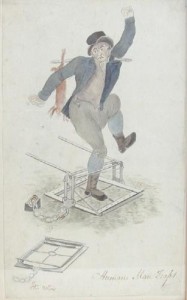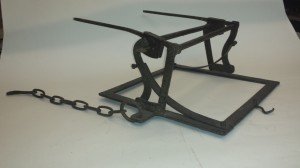Student Spotlight #2: Man Traps
Henrik Yau is a second year Archaeology student at the University of Reading, who chose to research our Man Traps because they caught his eye, because they looked dangerous and he had no prior knowledge of them.
I’ve always loved going to museums. Looking at vast collection of objects always excited me as a child, which probably stemmed from me collecting Pokémon cards (don’t judge, everyone did it), so when asked to go on a placement I immediately thought of museums. I took my placement at MERL because of my aspiration of working in a museum, and being allowed behind the scenes and actually handling museum objects is somewhat of a privilege, and seeing how a museum actually operates was insightful. I was also surprised to find English rural life isn’t just all about tractors and farming, and for my research it was Man traps that caught my eye.

The harsh conditions of rural districts drove men to poaching in order to feed their families as a means of survival. Those forced to poach may have lost their jobs as game keepers, farmers or travelling gypsies. The small populated, dense woodland fields and large estates were a haven for these illegal activities and became a poacher’s paradise.
Before the Norman invasion of 1066 anyone with permission to set foot on land could freely hunt, until William the Conqueror decreed he would claim vast acres of land to be set up as private preserves. Up until the Game Act of 1671 poachers had thought all game belonged to no one until caught. However, under the Game Act of 1671, landowners, their eldest sons or tenant farmers who became the only ones allowed to take game from the land. Because of this poaching became increasingly on the rise as peasants needed a way to feed their families and themselves, resulting in it becoming a capital offence under the 1723 Waltham Black Act. However, the law still didn’t deter poachers so Parliament made the trade of game entirely illegal in 1755.

Eventually poachers had become so frequent and the numbers of groups so great that local law enforcement was unable to attend every case of poaching. Throughout the 19th century there had been many cases of game keepers being killed and many seriously injured when battling violent poachers. While employing more game keepers was too expensive, estate owners began to employ the use of man traps which came to be known as ‘thigh crackers and body squeezers’. Man traps like the one pictured above are thought to have first circulated around England by 1770, and placed in plain sight to act as a deterrent. These initial traps would operate with two opposite weight-bearing springs and a pressure pad in the middle which, when stepped on, the razor sharp teeth attached to the jaws of the trap would close shut and catch any unsuspecting poacher. However, in May 1827 these non-humane man traps were outlawed.

In 1830, since there was still a high demand for traps, humane man traps were produced for estate/landowners. Humane man-traps like the one pictured above, and currently on display in the Museum’s collection of traps, was acquired in 1964 from an unknown donor. These traps would be placed in a hole dug in the ground in the middle of a used pathway, and covered up by placing leaves and grass on top. Humane traps such as this work by a pressure pad in the centre of the trap which had four prongs extending outwards in a north, east, south and west direction to keep the two barrels at the top of the trap and the curved flanges underneath the barrels firmly down in place. When an unsuspecting poacher disturbs the pressure pad it causes the prongs to be displaced and the flanges to abruptly surge up, forcing the two barrels to shut tightly on the leg of the poacher. The chain is used to lock the trap to a tree or another object. Unlike the inhumane man traps, anyone stepping on these traps could not easily free themselves as they were fitted with locks which could only be opened by gamekeepers who possessed the only key. Humane man traps such as this were manufactured by iron founder companies such as William Bullock & Co and Archibald Kendrick & Co in the West Midlands in towns such as Wolverhampton and West Bromwich.
Further Reading
Christy, M. 1902-1903. Man traps and spring guns. Outing, 41: 729-734.
Haddon-Riddoch, S. 2006. Rural reflection: a brief history of traps, trap makers and game keeping in Britain. Glendaruel: Argyll Publishing.
Jones, D.S.D.2000. A game keeping Miscellany. No place publication: No publisher.
Lovergrove, R. 2007. Silent field. The decline of a nation’s wildlife. Oxford: Oxford university press
Munsche, P.B. 1983. Pursuing Wild Symbols of Privilege: Munsche’s Gentlemen and Poachers: The English Game Laws 1671-1831. American bar foundation research journal, 8 (2): 481-489.
Museum of English Rural Life. 2014. Man traps. [Online] Available at: http://www.reading.ac.uk/adlib/Details/collect/4079 [Accessed 28th February 2014].
Watson, J. 1974. Poachers, and poaching. Wakefield: Ep Publishing LTD.
One thought on “Student Spotlight #2: Man Traps”
Leave a Reply
You must be logged in to post a comment.

Thanks for this. Not at all enough work done on this topic. Do the land enclosures also play a part in the increased use of man traps around 1800, perhaps?